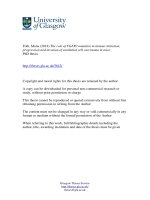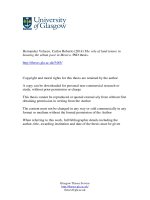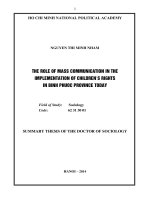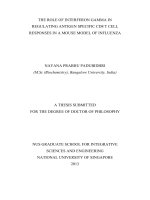The role of nutricline depth in regulating ocea1_yz
Bạn đang xem bản rút gọn của tài liệu. Xem và tải ngay bản đầy đủ của tài liệu tại đây (563.34 KB, 19 trang )
1
1
1The
role of nutricline depth in regulating ocean’s
2carbon cycle.
3
4Pedro Cermeño1, Stephanie Dutkiewicz2, Roger P. Harris3, Mick Follows2, Oscar
5Schofield1 & Paul G. Falkowski1,4
6
71 Environmental Biophysics & Molecular Ecology Program, Institute of Marine &
8Coastal Sciences, Rutgers University, 71 Dudley Rd, New Brunswick, 08901, New
9Jersey, USA.
102 Earth, Atmospheric, and Planetary Sciences, 77 Massachusetts Ave.,
11Massachusetts Institute of Technology, Cambridge, MA 02139-4307 USA
123 Plymouth Marine Laboratory, Prospect Place, Plymouth PL1 3DH, UK
134 Department of Earth and Planetary Science, Rutgers University, 610 Taylor
14Road, Piscataway, 08854, New Jersey, USA.
15
16Carbon uptake by marine phytoplankton, and its export below the
17thermocline, lowers the partial pressure of carbon dioxide (pCO2) in the
18upper ocean, and stimulates the diffusion of CO2 gas from the atmosphere1.
19Conversely, precipitation of calcium carbonate by marine planktonic
20calcifiers such as coccolithophorids increases pCO2, and promotes its
21outgassing2,3. Over the past ~50 million years, these carbon exchange fluxes
22between the atmosphere and the ocean have been largely controlled by the
2
1
1balance between diatom and coccolithophorid abundance, contributing
2significantly to the regulation of atmospheric pCO2 and Earth’s climate4,5.
3Yet, the mechanisms that control this critical balance remain poorly
4understood. The ecological distribution of these two phytoplankton
5functional groups has been linked to their distinct abilities to compete for
6nutrients6. Here we analyse phytoplankton community composition across
7latitudinal gradients in the Atlantic Ocean to show that the balance between
8diatoms and coccolithophorids is dependent upon the nutricline depth, a
9proxy of nutrient supply to the upper mixed layer of the ocean. Coupled
10atmosphere-ocean general circulation models (GCMs) predict a dramatic
11reduction in the nutrient supply to the euphotic layer as a result of increased
12ocean stratification7-9. Our findings indicate that, by shifting phytoplankton
13community composition, this causal relationship may lead to a decreased role
14of the biological pump in sequestering atmospheric CO2, implying a positive
15feedback in the climate system. These results are fundamental to understand
16the connection between upper ocean dynamics, the calcium carbonate-to17organic C production ratio and atmospheric pCO2 variations on time scales
18ranging from seasonal cycles to geological transitions.
19
Diatoms and coccolithophorids are derived from a common Rhodophyte
20ancestor, yet the evolutionary trajectories have channelled these two
21phytoplankton functional groups into distinct ecological strategies that have
22significant biogeochemical implications2,3,4,6,10,11. From an evolutionary
23perspective, they constitute an example of the classical ecological divergence of r24and K-strategists6. Diatoms, as opportunists, efficiently exploit resources in
25unstable, rarefied environments6,11,12. Coccolithophorids, possessing high affinity
26for nutrients and low resource requirements, may grow under quiescent conditions
3
1
1characteristic of stratified, open ocean waters11,12,13. The ecological distribution of
2these two phytoplankton functional groups has been hypothesised to be linked to
3the mechanisms that supply nutrients into the upper mixed layer of the ocean6,14.
4Here, we use data of phytoplankton biomass and species composition along with
5concurrent measurements of hydrographic variables from four Atlantic Meridional
6Transects (AMTs) (Fig. 1a, see also Supplementary Table 1) in order to elucidate
7the mechanisms that control the balance between diatoms and coccolithophorids
8in the ocean and their role in the carbon cycle.
9
Across latitudinal gradients in the ocean, the availability of inorganic
10nutrients exerts a major control on phytoplankton biomass, primary productivity
11and community structure15. Typically, high latitude, temperate and upwelling
12systems receive substantial amounts of nutrients from deep waters by wind-driven
13vertical mixing and fluid transport along isopycnal layers. In contrast,
14phytoplankton communities inhabiting low latitude environments, such as
15stratified, subtropical gyres, largely rely on local recycling and diapycnal nutrient
16fluxes to sustain their standing stocks. In general, high nutrient conditions
17enhance diatom productivity. Coccolithophorids, instead, are thought to be more
18widely distributed in oligotrophic ocean waters. Contrary to conventional
19wisdom, our data analysis showed shows that the biomass (and biovolume) of
20both, diatoms and coccolithophorids, increases consistently from subtropical
21regions to temperate and upwelling systems in response to increased nutrient
22supply (Fig. 1b). Though both phytoplankton groups exhibited similar latitudinal
23trends in biomass, our results revealed striking differences in their ranges of
24variation. Diatom biomass increased over four orders of magnitude from low
25latitudes to temperate and upwelling systems, whereas coccolithophorid standing
26stocks varied by two orders of magnitude (Fig. 1b). These latitudinal variations in
4
1
1diatom and coccolithophorid biomass were are consistent with their patterns of
2diversity (Fig. 1c). Again, their ranges of variation were remarkably different,
3with the number of diatom species varying two-fold more than coccolithophorids
4(Fig. 1c).
5
We found a striking correspondence between the coccolithophorid-to-
6diatom (C/D) ratio and the nutricline depth (Fig. 2). Specifically, our analysis
7indicates that, across the entire latitudinal gradient considered, coccolithophorids
8rapidly rise to dominance relative to diatoms as the water column stratifies and
9the nutricline deepens in the ocean.
10
When physical mixing increases, the upper mixed layer penetrates the
11nutricline, thereby providing nutrients to the euphotic zone, and either the
12nutricline shoals or nutrients become elevated throughout the water column (i.e.,
13zero-depth nutricline in this study). Conversely, when stratification increases, the
14upper mixed layer is deprived of nutrients, which leads to a progressive deepening
15of the nutricline. The depth of the nutricline may thus be used as a proxy of
16nutrient supply into the upper mixed layer of the ocean. In fact, the primary
17productivity of phytoplankton is negatively correlated with the depth of the
18nutricline (Supplementary Fig. 1). This inverse relationship suggests a strong
19coupling between the position of the nutricline in the water column, the rate of
20nutrient supply into the euphotic layer, and the photosynthetic performance of
21phytoplankton.
22
Different factors, such as the availability of silicic acid16, the mineral used
23by diatoms to construct their cell walls, or the saturation state of seawater with
24respect to calcium carbonate, a key controller of calcification17, have been put
5
1
1forward to explain the distribution of diatoms and coccolithophorids in different
2marine environments. For instance, the low silicate-to-nitrate input ratios
3characteristic of the equatorial Pacific Ocean are thought to limit diatom
4productivity and C drawdown in this high nutrient-low biomass ocean region16.
5Though these factors play a role, our study, covering temperate, upwelling,
6tropical, subtropical, and equatorial ecosystems, lends weight to the view6 that
7upper ocean turbulence and nutrient supply dynamics exert a dominant control
8upon the ecological selection and evolutionary success of these two
9phytoplankton functional groups in the ocean. In this lineIn line with this, a suite
10of competition experiments in chemostats have shown that the population
11dynamics of diatoms and coccolithophorids can be controlled by simply varying
12the rate of nitrate supply with the C/D-ratio going up and down in response to
13steady-state and nutrient pulsing conditions, respectively (unpublished results).
14Remarkably, the strong linkage between the nutricline depth and phytoplankton
15community composition reported here arises despite that, in nature, ecological
16systems are influenced by manifold and ever changing environmental templates
17and complex biotic interactions.
18
Our field observations illustrate very well how the balance between diatoms
19and coccolithophorids is primarily driven by variations in diatom biomass and
20diversity, with coccolithophorids exhibiting comparatively minor response to
21environmental variability (Fig. 1b,c). But why do these phytoplankton groups
22exhibit such different ranges of variability?
23
Microbial plankton are ubiquitous in the world oceans. Their global
24biogeography is determined by local environmental factors that select for a
25particular species based on its optimal growth potential. According to this
6
1
1‘universal distribution, local selection rule,’ the patterns depicted here for diatoms
2and coccolithophorids reflect their divergent life histories and survival
3strategies6,11,12,13. Diatoms, afforded by their high maximum growth rates, luxury
4nutrient uptake, and ability to store inorganic nutrients in vacuoles, exploit
5unstable environments where resources are supplied in excess relative to
6biological demand6,12,14, and diatoms bloom. But adaptation to unstable
7environments imposes severe nutritional constraints under stable conditions.
8Prolonged stability, such as increased ocean stratification, drives plankton
9ecosystems to operate near their carrying capacity (i.e., resource demand-to10supply ratio close to unity) and, under these conditions, ecological selection
11depends primarily on the ability of each individual species to compete for limited
12resources18. With the exception of species that migrate vertically and take up
13inorganic nutrients in the vicinity of the nutricline, or in symbiotic association
14with nitrogen fixers, diatoms are at a disadvantage under strong resource
15limitation due to their high nutritional requirements and high half saturation
16constants12. Consequently, across contrasting marine environments, the
17distribution of diatoms is inextricably tied to ample variations in biomass and
18diversity (Fig. 1b,c). In contrast, coccolithophorids have lower maximum nutrient
19uptake and growth rates12,19. Instead, they possess low half saturation constants for
20nutrient uptake and small intracellular nutrient quotas (i.e., low nutritional
21requirements)12. These ecophysiological features allow coccolithophorids to
22inhabit a broad array of open oceanic environments without succumbing to
23dramatic variations in standing stocks (Fig. 1b,c).
24
The impact of nutrient limitation on the competitive success of diatoms and
25coccolithophorids has profound implications. Changes in the C/D-ratio may alter
26the efficiency of the biological pump by controlling the balance between two key
7
1
1processes, i) export of carbon into the ocean interior, and ii) release of CO2 due to
2coccolithophorid calcification (i.e., ‘alkalinity pump’, each mole CaCO3
3precipitated results in ~0.7 mole CO2 released, assuming present CO2
4concentrations, temperature T = 12 C and salinity S = 35) (ref. 3). Consequently,
5for a given rate of organic productivity, an increase in the C/D-ratio will lead to a
6decreased role of the biological pump in sequestering atmospheric CO2 (refs. 3,
720). Our analysis shows that major changes in the C/D-ratio are linked to the
8stabilisation-destabilisation of the water column (Fig. 2). Low latitude, stratified
9ecosystems are dominated by coccolithophorids (C/D-ratio >> 1), and therefore
10increased stratification bears little effect on the CaCO3-to-organic C production
11ratio. However, in unstable environments, characterised by a significant
12contribution of diatoms, the onset of water column stratification (and subsequent
13nutrient depletion) causes a rapid floristic shift, increases the CaCO3-to-organic C
14mass ratio, and reduces to a far greater extent the efficiency of the biological
15pump (Fig. 2).
16
Current evidence and modelling work suggest that climate warming will
17increase ocean stratification, and hence reduce nutrient exchange between the
18ocean interior and the euphotic layer7-9. Recent reports highlight that, indeed,
19these climate driven trends in upper ocean stratification and primary productivity
20across the central, oligotrophic gyres are already detectable and may be occurring
21faster than model expectations21. Yet, predicting the impact that these changes
22may exert on the ecological functioning of marine plankton ecosystems remains
23elusive22. In order to investigate possible shifts in the distribution of diatoms and
24coccolithophorids caused by climate warming, we projected our empirical model
25between the coccolithophorid-to-diatom (C/D) ratio and the nutricline depth onto
26a coupled atmosphere-ocean general circulation model (GCM) (see
8
1
1Supplementary information for details). This three dimensional GCM was forced
2by the Intergovernmental Panel on Climate Change (IPCC) IS92a ‘continually
3increasing’ CO2 scenario (880 p.p.m.v. in the year 2100). By the end of this
4century, in this model configuration and CO2 scenario, the increased upper ocean
5stratification reduces the supply of macronutrients to the euphotic layer, deepens
6the nutricline and leads to a reduction by 14 % in global oceanic primary
7productivity (Supplementary Figs. X). The projection of our empirical model
8shows dramatic increase in the C/D-ratio across vast areas in the North Atlantic,
9but particularly pronounced in temperate ecosystems (Fig. 3). By the year 2100,
10the C/D-ratio in the North Atlantic temperate region increases by >80 % relative
11to year 2000. In both hemispheres, the expansion of subtropical systems into
12temperate, equatorial and upwelling regions causes striking shifts in ecosystems
13characterized in the present day by a significant contribution of diatoms (Fig. 3).
14
Our prognostic analysis indicates that, in a climate warming scenario, the
15progressive stratification of oceanic systems will increase the C/D-ratio, reducing
16the potential of marine plankton ecosystems to drawdown atmospheric CO2 (ref.
1720). The model finds that oceanic regions subjected to the influence of the
18expansive subtropical gyres, such as the North Atlantic drift province or tropical
19upwelling systems, could be particularly susceptible to this biogeochemical
20control (Fig. 3). Aside from shifting the C/D-ratio, increased ocean stratification
21and nutrient limitation may decrease primary productivity and export fluxes 7,
22especially those associated with diatoms23. The efficiency of the biological pump
23could further change if, as expected, the invasion of anthropogenic CO2 into the
24ocean alters the rates of coccolithophorid calcification and/or phytoplankton C25consumption (hence deviating the C/N stoichiometry from a static Redfield
26ratio)24,25. A sensitivity analysis indicates that the biogeochemical control
9
1
1described in this study (positive feedback on climate) could be of magnitude
2comparable, but inverse, to experimentally-observed reductions in
3coccolithophorid calcification (negative feedback) (Supplementary Fig. X). If, on
4the contrary, coccolithophorid calcification increases, as recent reports suggest 26,
5the storage capacity of the surface ocean for CO2 would decrease, which, united to
6the smaller ability of marine plankton ecosystems to drawdown atmospheric CO2,
7would cause a larger reduction of the biological pump’s efficiency.
8
Margalef’s thesis that external energy input determines phytoplankton
9community structure6 is empirically demonstrated here. Over the past ~50 million
10years, diatoms and coccolithophorids have responded incessantly to upper ocean
11turbulence and nutrient exchange dynamics, contributing significantly to the
12regulation of atmospheric pCO2 and Earth’s climate4,5,14,27. Consistent with the
13geological record and the classical ‘Mandala’ of Margalef, our results indicate that
14the relative distribution of diatoms and coccolithophorids is strongly dependent
15upon the mechanisms that supply nutrients into the upper mixed layer of the
16ocean. We suggest that this mechanistic connection is majorly responsible for the
17ecological succession and long-term, regime shifts of these two phytoplankton
18functional groups in the ocean. If so, these taxonomic shifts, and their associated
19impacts on net air-sea CO2 exchange, would be linked mechanistically to the
20seasonal dynamics of the upper mixed layer, interannual variations in climatic
21forcing22,28, contemporaneous trends in anthropogenic climate warming20,22,27, and
22the historical climate change14,27,29.
23METHODS SUMMARY
24Physical, chemical and biological variables were obtained from four Atlantic
25Meridional Transect cruises (50N-50S). Micromolar concentrations of inorganic
10
1
1nutrients were determined on fresh samples using standard techniques. For each
2station, the depth of the nutricline was taken to be the first depth where nitrate
3was detected (> 0.05 μM). Samples for identification and counting of
4phytoplankton were analysed using an inverted microscope (Utermhol’s
5technique). Cell numbers were expressed in terms of carbon using biovolume
6estimates and volume to carbon conversion factors.
7The potential of marine phytoplankton to drawdown atmospheric CO2 was
8calculated from the C/D(biomass)-ratio considering the opposing effects of
9photosynthesis and calcification3. We assumed a fixed CaCO3-to-organic C
10production ratio in coccolithophorids of 1. The moles of CO2 released by mole of
11CaCO3 precipitated, also known as ‘Revelle factor’ were calculated from
12analytical equations3.
13The numerical simulation of change in ocean nutrient distribution was performed
14using an earth system model of intermediate complexity. The model incorporates
15an explicit C cycle model with a parameterization of the biological export
16production limited by the availability of light and nutrients. This biogeochemical
17component follows the fate of a macro-nutrient, dissolved organic matter,
18alkalinity and dissolved inorganic carbon. Simulated changes in the nutricline
19depth enabled to prognosticate the relative distribution of diatoms and
20coccolithophorids over this century using our empirical relationships.
21
221.
Volk, T. & Hoffert, M. I. in The Carbon Cycle and Atmospheric CO2: Natural
23
Variations Archean to Present (eds Sundquist, E. T. & Broecker, W. S.) 99–
24
110 (Am. Geophys. Union, Washington DC, 1985).
11
1
12.
Holligan, P. M. & Robertson, J. E. Significance of ocean carbonate budgets
2
for the global carbon cycle. Glob. Change Biol. 2, 85–95 (1996).
33.
Frankignoulle, M., Canon, C. Gattuso, J-P. Marine calcification as a source
4
of carbon dioxide: Positive feedback of increasing atmospheric CO2. Limnol.
5
Oceanog. 39, 458– (1994).
64.
Falkowski, P. G., et al. The evolution of modern eukaryotic phytoplankton.
7
Science 305, 354–360 (2004).
85.
Archer, D. & Maier-Reimer. Effect of deep-sea sedimentary calcite
9
preservation on atmospheric CO2 concentration. Nature 367, 260-264 (1994).
106.
Margalef, R. Life forms of phytoplankton as survival alternatives in an
11
unstable environment. Oceanologica Acta 1, 493–509 (1978).
127.
Bopp, L. et al. Potential impact of climate change on marine export
13
production. Glob. Biogeochem. Cycles 15, 81– (2001).
148.
Boyd, P. W. & Doney, S. C. Modelling regional responses by marine pelagic
15
ecosystems to global climate change. Geophys. Res. Lett. 29, 1806– (2002).
169.
Sarmiento, J. L. et al. Response of ocean ecosystems to climate warming.
17
Glob. Biogeochem. Cycles 18, GB3003 (2004).
1810. Smetacek, V. Diatoms and the ocean carbon cycle. Protist 150, 25–32 (1999).
1911. Reynolds, C. S. Ecology of phytoplankton. (Cambridge Univ. Press,
20
Cambridge, 2006).
2112. Litchman, E., Klausmeier, C. A., Schofield, O., Falkowski, P. G. The role of
22
functional traits and trade-offs in structuring phytoplankton communities:
23
scaling from cellular to ecosystem level. Ecol. Lett. 10, 1170–1181 (2007).
12
1
113. Iglesias-Rodríguez M. D., et al. Representing key phytoplankton functional
2
groups in ocean carbon cycle models: Coccolithophorids. Glob. Biogeochem.
3
Cycles 16, GB001454 (2002).
414. Tozzi, S., Schofield, O., Falkowski, P. G. Historical climate change and
5
ocean turbulence as selective agents for two key phytoplankton functional
6
groups Mar. Ecol. Prog. Ser. 274, 123–132 (2004).
715. Longhurst, A. R., Sathyendranath, S., Platt, T. & Caverhill, C. An estimate of
8
global primary production in the ocean from satellite radiometer data. J.
9
Plank. Res. 17, 1245–1271 (1995).
1016. Dugdale R. C. & Wilkerson F. P. Silicate regulation of new production in the
11
equatorial Pacific upwelling. Nature 391, 270–273 (1998).
1217. Tyrrell, T. Calcium carbonate cycling in future oceans and its influence on
13
future climates. J. Plank. Res. 30(2), 141–156 (2008).
1418. Tilman, D., Kilham, S. S. & Kilham, P. Phytoplankton community ecology:
15
the role of limiting nutrients. Ann. Rev. Ecol. Sys. 13, 349–372 (1982).
1619. Buithenius, E. T., Pangerc, T., Franklin, D. J., LeQuere, C. & Malin, G.
17
Growth rates of six coccolithophorid strains as a function of temperature.
18
Limnol. Oceanogr. 53, 1181–1185 (2008).
1920. Denman, K., Hofmann, U. & Marchant, H. in Climate change 1995, The
20
science of climate change (eds Houghton, J. T., Meira Filho, L. G., Callander,
21
B. A., Harris, N, Kattenberg, A. & Maskell, K) (Cambridge Univ. Press.,
22
1996).
2321. Polovina J. J., Howell, E. A., & Abecassis, M. Ocean's least productive
24
waters are expanding. Geophys. Res. Lett., 35, L03618 (2008).
13
1
122. Boyd, P. W. & Doney, S. C. in Ocean Biogoechemistry, The Role of the
2
Ocean Carbon Cycle in Global Change (ed. Fasham, M. J. R.) (Springer-
3
Verlag, Berlin, 2003).
423. Bopp, L., Amount, O., Cadule, P., Alvain, S. & Gehlen, M. Response of
5
diatoms distribution to global warming and potential implications: a global
6
model study. Geophys. Res. Lett. 32, L19606 (2005).
724. Zondervan, I. Zeebe, R. E., Rost, B. & Riebesell, U. Decreasing marine
8
biogenic calcification: a negative feedback on rising atmospheric pCO2.
9
Global Biogeochem. Cycles 15, 507-516 (2001).
1025. Riebesell, U. et al. Enhanced biological carbon consumption in a high CO2
11
ocean. Nature 450, 545–548 (2007).
1226. Iglesias-Rodríguez M. D., et al. Phytoplankton calcification in a High-CO2
13
world. Science 320, 336–340 (2008).
1427. Falkowski, P. J. & Oliver, M. J. Mix and match: how climate selects
15
phytoplankton. Nature Rev. Microbiol. 5, 813–819 (2007).
1628. Antia, A. et al. Basin-wide particulate carbon flux in the Atlantic Ocean:
17
Regional export patterns and potential for atmospheric CO2 sequestration.
18
Glob.. Biogeochem. Cycles 15, 845-862 (2001).
1929. Archer, D. Winguth, A., Lea, D. & Mahowald, N. What caused the
20
glacial/interglacial pCO2 cycles? Revs. Geophys. 38, 159-189 (2000).
21
22Supplementary Information is linked to the online version of the paper at
23www.nature.com/nature.
1
14
1Acknowledgements We thank all those who participated in the collection of data, in particular D.
2Harbour for microscopy analyses, and S. Costas, A. Kahl, E. Marón and Y. Rosenthal for
3discussion and comments on the manuscript. E. M. provided access to his primary productivity
4data. Atlantic Meridional Transect (AMT) data collection was supported by the UK Natural
5Environmental Research Council through the AMT consortium (NER/O/S/2001/00680). P.C. was
6supported by Marie Curie Outgoing International Fellowship from the European Union.
7Author Contributions P.C., O.S. & P.G.F. designed the research. R.P.H. managed the
8phytoplankton database. P.C. conducted the analysis of phytoplankton data. S.D. & M.F.
9performed the modelling section. P.C. wrote the paper.
10Author Information Reprints and permissions information is available at
11www.nature.com/reprints. The authors declare no competing financial interests. Correspondence
12and requests for materials should be addressed to P.C. () or P.G.F
13().
14
15
16
17
18
19
20
1
15
1Figure Legends
2Figure 1. Phytoplankton distribution in the Atlantic Ocean. a, AMT cruises
3track overlain on an annual climatology of chlorophyll showing high values
4where surface nutrients are elevated. b, Latitudinal distribution of biomass
5of diatoms (blue) and coccolithophorids (red). c, as b but for number of
6species. Solid lines in panels b and c are biomass and number of species
7averaged each 5 of latitude. Dashed lines are the range of data values.
8Figure 2. Nutricline depth controls the coccolithophorid-to-diatom (C/D)
9ratio. Data points are 5 zonal averages of C/D-ratio and nutricline depth
10from four Atlantic latitudinal transects (solid circles) and two coastal
11stations (open circles, see supplementary information). The left Y-axis is
12represented on a log-scale in order to highlight the rapid shift from diatom
13to coccolithophorid dominance in response to the onset of water column
14stratification. Colour lines are the least square linear regression models:
15[C/D (biomass) = 0.14 + 0.14 * ND, r2 = 0.78, p < 0.0001], and [C/D
16(diversity) = 0.55 + 0.03 * ND, r2 = 0.83, p < 0.0001]. Changes (%) in the
17biological potential for atmospheric CO 2 sequestration were estimated
18from the model equation considering the opposing effects of
19photosynthesis and calcification (thick solid line, see Supplementary
20information for details). Confidence intervals were obtained from the range
21of data values (as shown in Fig. 1b, thin solid lines). Note that major
22changes are associated with the stabilisation/destabilisation of water
23column. Reduction in pump’s efficiency considering changes in the
24buffering capacity of the ocean’s carbonate system in a future, high CO 2
25scenario was also displayed (dashed line, see Supplementary
26information).
1
16
1Figure 3. Projected changes in the distribution of diatoms and
2coccolithophorids over this century. a, Coccolithophorid to diatom (C/D)
3biomass ratio in year 2000. b, as a but for 2100 (assuming IPCC IS29 CO2
4‘continually increasing’ scenario).
5
17
1
1
a
2
b
c
3
4
5
6
Figure 1.
1
18
1
2
3
4
5
6
7
8
9
10
11
12
13
14
Figure 2.
19
1
1
2
3
4
5
6
7
8
9
10
Figure 3.









